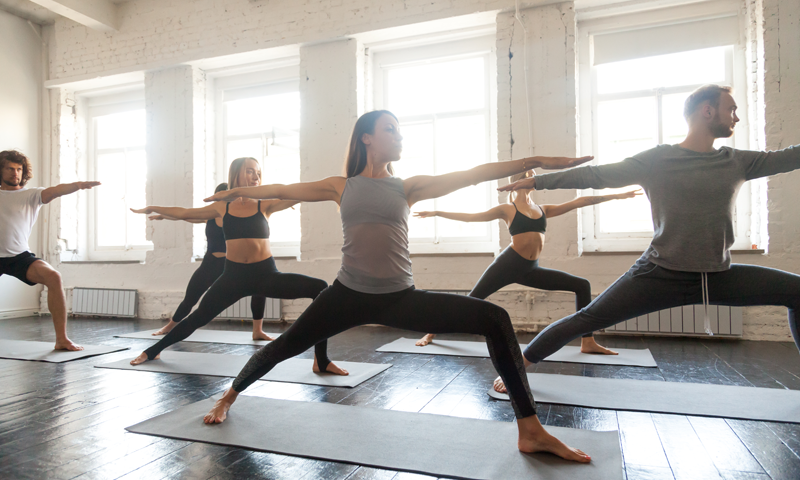
The Best Yoga Mobile Apps
26th September 2019
The Powerful Ways Yoga Can Help with Posture
3rd October 2019Yoga for High Blood Pressure

High blood pressure, also known as hypertension, greatly increase your risk of a stroke and heart disease. Thankfully, there are ways to manage the condition, including medication, exercise, maintaining a healthy weight and stress reduction. Interestingly, yoga can combat high blood pressure by serving as a form of exercise and reducing your stress levels. In this article, we explore yoga for high blood pressure. If you’re looking for a holistic way to manage high blood pressure, throw on a yoga top and hit the studio!
Bridge Pose
The first posture on the list is Bridge Pose. To practice the asana, start by laying on your back with your knees bent. The soles of your feet should stay touching the ground. Relax your arms and let them drop down to the sides of your body. Tuck your chin into your chest then lift your bottom and back off the floor to create a bridge. You are in Bridge Pose. Hold for 15 seconds before lowering your back and bottom back down to the mat.
Legs Up The Wall Pose
To practice Legs Up the Wall Pose, place the shortest side of your yoga mat against a wall. When your mat is in place, sit down facing the wall. Gently lie back on the mat and extend both legs up the wall. Make sure that your bottom is almost touching the wall and that your legs are close together. You can either rest your hands on your stomach or on the mat – whichever feels most comfortable. You are in Legs Up The Wall Pose. Close your eyes and relax, holding the pose for around 5 minutes.
Dolphin Pose
To practice Dolphin Pose, start on all fours. Ensuring your knees are set directly beneath your hips, bring your forearms down to the floor with your shoulders above your hands. Once in position, touch your palms together whilst keeping your forearms on the floor. Next, curl your toes under and gently lift your knees away from the ground. Begin to lengthen your tailbone and lift your bottom towards the ceiling. Your body should now form an upside-down ‘V’ shape. At this stage, beginners may find it easier to keep their knees slightly bent. Keeping your forearms pressed firmly into the floor, engage your shoulder blades by drawing them towards your back. It’s important to not let your head hang aimlessly when in this position; instead, support it between your upper arms. You are now in Dolphin Pose. Hold the asana for around 30 seconds before bringing your knees back down to the floor.
Reclining Big Toe Pose
To practice Reclining Big Toe Pose, start by lying flat on your back. Gently bend both knees and place your feet on the ground. Next, lift your right leg off the mat and begin to draw your knee towards your chest. If it helps, you can use your hands to draw your knee in. Slowly straighten your left leg and rest it down on the mat. Using your fingertips, gently grip the toes of your right foot. If possible, try to straighten your right leg. If your leg doesn’t straighten all the way – that’s fine! As long as you can feel a stretch through your ankle and calf, the posture is doing its job. You are in Reclining Big Toe Pose. Hold the position for 30 seconds before switching sides.

Downward Dog
To practice Downward Dog, stand tall with your feet shoulder-width apart. Bending at the waist, slowly lower your torso forward until your body forms a triangle. Your hands and feet should now be securely on the ground. If your shoulders or hamstrings feel too tight for the pose, try bending your knees slightly to make the posture easier. Spreading your fingers for additional balance, move your head forward until it is in-between your upper arms. You are in Downward Dog. For best results, breathe deeply whilst practising the pose and hang your head gently between your shoulders.
Forward Fold
To practice Forward Fold, stand tall with your feet directly beneath your hips. Gently bend forward at the waist and begin to lower your upper body toward the floor. To ensure pressure on the lower back is minimized, remember to bend your knees generously throughout the pose. Next, take hold of your ankles and let your body hang naturally toward the floor. You are in Forward Fold. Hold the posture for 1 minute whilst breathing deeply. To increase the stretch, gently sway your torso or head from side to side.
Seated Forward Bend
To practice Seated Forward Bend, begin seated with your legs together and your hands by your sides. Lift your chest and lower your upper body towards your legs. Engage your abdominals and imagine your stomach moving toward your thighs. You are in Seated Forward Bend. If you can’t bend all the way, don’t panic! As long as you feel a stretch through your upper and lower back, the asana is doing its job.
Bound Angle Pose
To practice Bound Angle Pose, begin in a seated position. Bending your knees out to the sides, bring the soles of your feet together and interlace your fingers around the toes. As you inhale, press your pelvis down into the mat and extend your spine. Draw your shoulders down and back and move your chest forward. Finally, press your knees down into the mat to increase the stretch. You are in Bound Angle Pose. Hold the asana for 5-8 breaths before releasing.
Corpse Pose
Designed to calm the body and mind, Corpse Pose is the perfect way to end your routine. To practice the asana, start by lying on your back. Finally, relax your arms by your sides and close your eyes. You are in Corpse Pose. Take this time to concentrate on your breathing or reflect on the rest of your routine.
In Summary
Whether you suffer from high blood pressure or want to prevent its onset, practice yoga for high blood pressure to reap the benefits. In the warmer months, many yogis like to practice outside. If you do so, remember to wear a yoga cap and a good-quality SPF to protect your skin from the UV rays.

